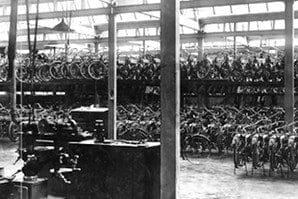
This photograph is actually only a portion of a much larger image of several hundred Douglas machines in storage, though the original photograph remains frustratingly elusive.
As of early 1915, only eight British firms manufactured magnetos, and none of them made them in the quantities that the motorcycle industry was demanding. The ever-increasing number of motorcycle manufacturing companies meant that the demand for components such as the magneto was constantly on the rise. The British industry in this era was almost entirely reliant on foreign imports and the German industry, led by companies such as Bosch, was the largest supplier of magnetos by a considerable distance.
These German magnetos were high quality components, and this did not help the British industry as competition with the German firms was extremely tough. Price cutting also meant that the German firms could often offer quite lucrative deals that kept their coffers full.
Enjoy more classic motorcycle reading, Click here to subscribe to one of our leading magazines.
Several marques, including Douglas, asked American companies to manufacture magnetos after the First World War broke out and German components abruptly became unavailable.
In February 1915 The Motor Cycle published an impassioned plea to British industrialists, urging the magneto firms to make greater quantities of magnetos and the motorcycle manufacturers to buy more of these locally constructed components.
To emphasise the appeal, The Motor Cycle wrote: “In our opinion, it is the duty of every patriotic motor cycle manufacturer to purchase magnetos, so far as it is possible, in this country, and thus help bring success to those firms who have stepped into the breach, and so soon as to see every British motor cycle and car equipped with a British magneto.”
The motorcycles in the photograph look to be the 1914 Douglas models. The petrol tanks and engines of the machines on the upper level are certainly indicative of the 1914 (2¾hp) 350cc side-valve models, though Douglas offered other bigger engine models too, so it is possible that this warehouse contains an assortment of machines from around 1914.
The unfortunate scarcity of readily available magnetos resulted in many makers having to put some of their machines into storage until the parts became available – Douglas, though clearly badly affected, was not alone.
In the years that followed, Douglas would play a huge part in the First World War. Douglas and Triumph were the chief providers of British motorcycles for use by the military, and the vast majority of dispatch riders would find themselves astride a machine from one of these two great British names.
The two marques, Triumph in particular, had developed a reputation for sturdiness and reliability; two facets that definitely made them adequate machines for the rigours of Europe during wartime and thus helped Triumph and Douglas obtain contracts from the British military. Douglas provided 2¾hp and 4hp models, the former the majority, the latter often being coupled with a sidecar.
The engines were typically the 348cc power units that had become fairly standard appointments to Douglas machines in previous years. Triumph provided 4hp (550cc) singles, the most notable of which was the ‘Trusty Triumph’ – the Triumph Model H.
The Douglas machines of this period only had two slight faults. The first was that the front fork could buckle and snap if the riding conditions became too rough. The second was that the spark plug allocated to the front cylinder would occasionally short out in wet weather. Let us hope that the Douglas machines in the photograph, once equipped with magnetos, performed well and did their duty.


